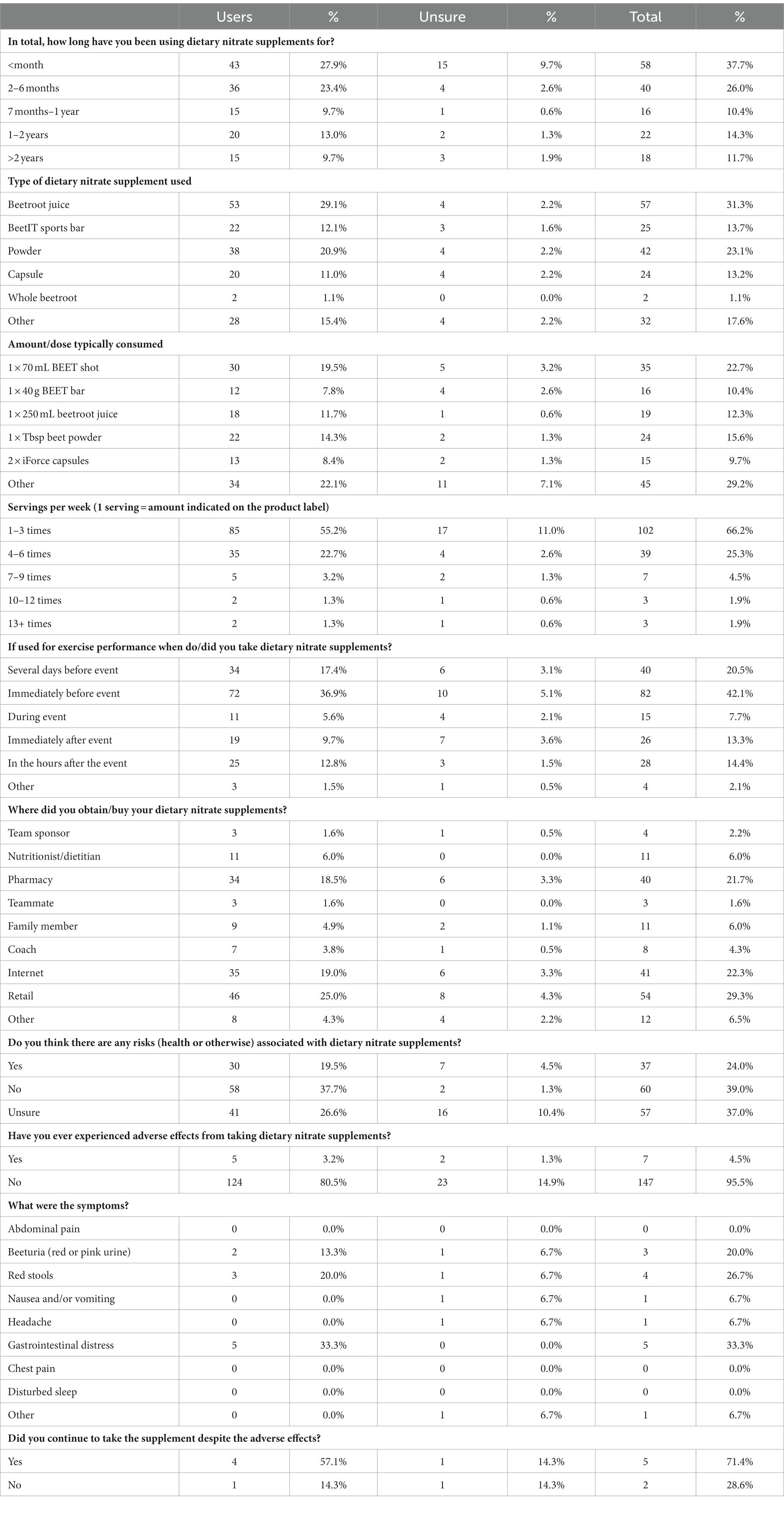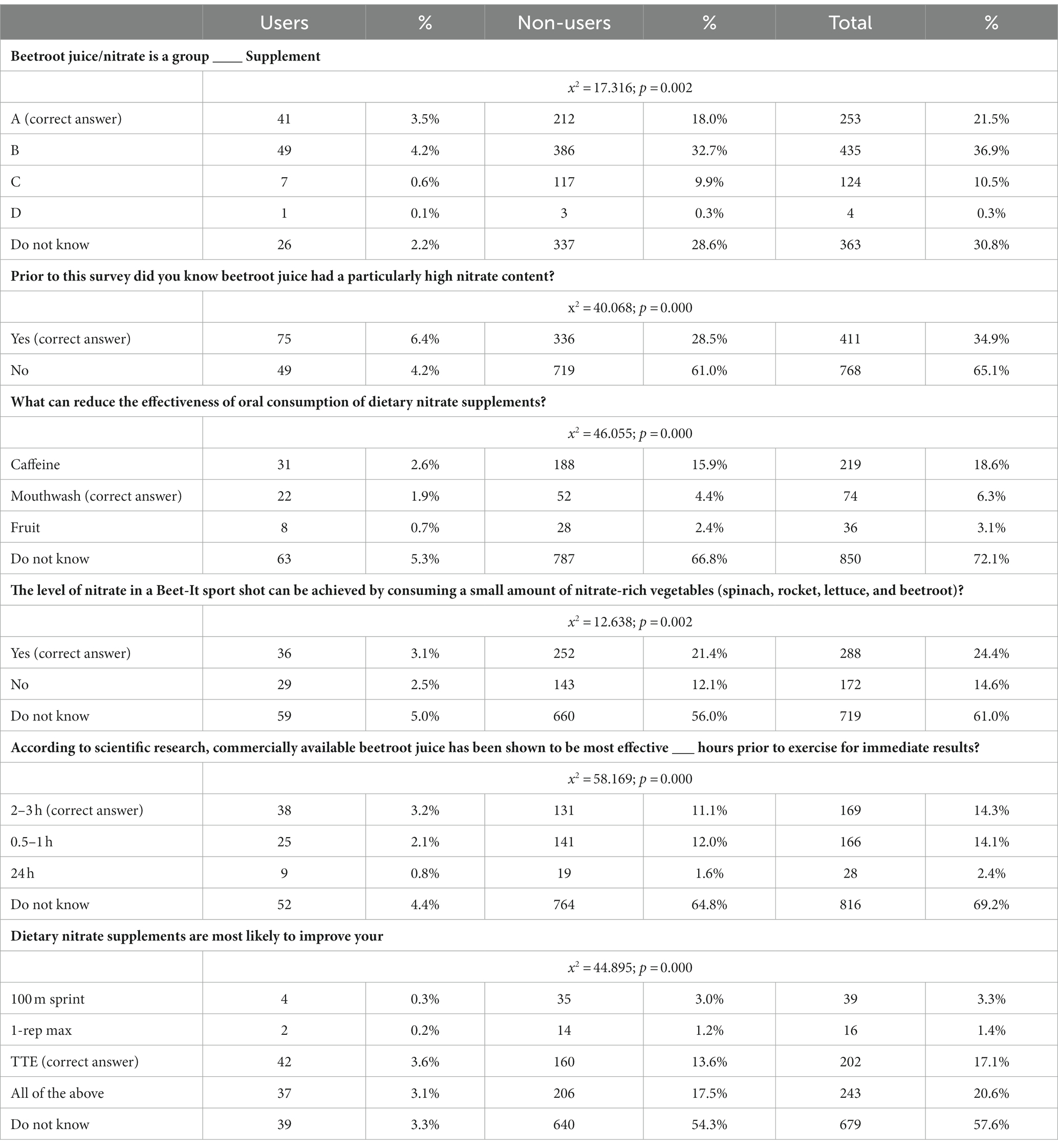- 1School of Human Movement and Nutrition Sciences, University of Queensland, St. Lucia, QLD, Australia
- 2School of Exercise and Nutrition Sciences, Queensland University of Technology, Kelvin Grove, QLD, Australia
Introduction: Use of nitrate as a dietary supplement has gained popularity among athletes and recreationally active individuals to enhance exercise performance. However, the prevalence and patterns of use, and knowledge of nitrate as a dietary supplement are unknown.
Methods: Individuals (≥16y) completed a 42-item online questionnaire to collect (i) sociodemographic information; (ii) participation in activity and sport; (iii) nitrate supplementation use and reasons; (iv) attitudes and beliefs regarding information sources and the safety of nitrate as a dietary supplement; and (v) knowledge of dietary nitrate supplements.
Results: In total, 1,404 active adults (66% female) took part in the study. Only about one in 10 respondents (11.9%) reported they had consumed dietary nitrate (“users”) in the past, most commonly as beetroot juice (31.3%). Over two-thirds (69.4%) of users could not correctly identify the correct timing of intake relative to performance time to best improve exercise performance, and most users (82.3%) were unsure of the contraindications to oral consumption of dietary nitrate supplements. Only 3.9% of users experienced adverse effects after ingesting dietary nitrate supplements. Among non-users, the most common reasons respondents selected for not using dietary nitrate supplements were “I do not think I need to” (70.2%) and “I have never thought about it” (69.2%).
Discussion: There is evidence to support the efficacy of dietary nitrate intake in improving exercise performance. However, findings from this study suggest dietary nitrate is under-utilized. Educational messages that target dietary nitrate consumption should be targeted toward nutritionists, coaches, and exercise physiologists to bridge the gap between knowledge-to-practice.
Introduction
According to the World Health Organization (WHO), almost 80% of the global population use dietary supplements (1), often motivated by improving health and immunity, losing weight, increasing muscle mass, or improving skin and hair (2). The use of supplements among active adults has also been well documented (3–9), and often used to enhance exercise performance, increase their tolerance for more intense training, or for better recovery and training adaptations (10, 11). Dietary supplements may be in the form of extracts or concentrates from plants or animal-derived ingredients (such as whey protein), available as capsules, tablets, liquids, soft gels, powders and bars (11).
Commercially available beetroot juice, often in the form of “shots,” are becoming more commonplace in Australia, and promoted for use to enhance exercise performance (12). These drinks provide an acute, concentrated dose of nitrate of (NO3−), purposefully designed as a more convenient and palatable option (13). We have previously reviewed the evidence regarding the efficacy of nitrate as an ergogenic aid (12). Findings from our systematic review and meta-analysis of 76 trials across 47 studies suggest that dietary nitrate supplementation is likely to elicit a positive outcome when testing endurance exercise capacity but is less likely to be effective for time-trial performance. Doses of nitrate varied between studies from 4.1 mmol (~254 mg) to 19.5 mmol (~1,209 mg) administered on each trial day, and beetroot juice was the most common supplement source. Findings from our review have also been substantiated by more recent reviews, such as that of Senefeld et al. (14). While it is unlikely that consumption of beetroot juice or other vegetable sources of nitrate is harmful (and may, in fact, offer other health benefits), chronic use of nitrate supplements has not been well studied (12).
Anecdotally, the use of nitrate-rich beetroot juice was used extensively, and with significant benefit, by elite athletes from prominent countries competing at the 2012 London Olympic and Paralympic Games (15). However, it is still unclear if the use of dietary nitrate as a form of supplementation is widespread and how the knowledge from research studies is being translated. Despite the recent body of evidence supporting the ergogenic effect of dietary NO3− on exercise performance, little is known about the knowledge and use of NO3− as a supplement among active adults.
There is widespread availability of supplements, but studies evaluating the prevalence of their use, knowledge, attitudes and beliefs among consumers are scarce (2). Dietary supplements are available for purchase from supermarkets, pharmacies and fitness centers, without any medical prescription (16), and can lead to misuse. Social media has become a popular medium to share nutrition information, and individuals have high levels of trust in the information they see online (17). However, health misinformation on social media is widespread, particularly in relation to nutrition (18). Advertising products on social media, particularly supplements, is ubiquitous (19). Dietary NO3− supplements are relatively new on the market, little is known about the “knowledge-to-action” gap (20). Therefore, the objectives of this study were to: (i) assess the prevalence of use of dietary NO3− supplements among a sample of active adults; (ii) understand the frequency and pattern of their use; (iii) assess self-reported beliefs on the efficacy of dietary NO3− supplementation as an ergogenic aid; (iv) investigate consumers motivations for using or abstaining from dietary NO3− supplementation; and (v) explore the differences in NO3− use between different socio-demographic characteristics.
Materials and methods
Participants and recruitment
This study was approved by the Human Research Ethics Committee of The University of Queensland – Approval number: HMS16/1210. Participants were recruited through print and media advertising via word of mouth and snowball sampling. Posters and flyers were distributed via university notice boards, mailing lists, cycling clubs/cafes, fitness and health centers, cafes, and a study website. Interested participants were encouraged to contact the lead investigator and were provided with more information about the study and had their questions answered. Individuals were considered eligible if they were healthy and active (≥150 min per week of moderate to vigorous physical activity by self-report) adults aged ≥16 years. Participants were excluded from the study if they (1) had history of clinical illness or disease such as new or possible symptoms; (2) were currently being treated with a diuretic; (3) had smoked cigarettes or quit smoking in the last 3 months; (4) had a body mass index below 18.5 kg/m2 or above 34.9 kg/m2; (5) were insufficiently active (<150 min per week of moderate to vigorous physical activity); (6) were unable to read or speak English; (7) were pregnant or lactating.
Completion and submission of the questionnaire was considered as informed consent and responses were anonymous. After completing the questionnaire, participants had the option to provide their email address to be entered into a draw to win one of four gift cards. Where participants opted into the draw, questionnaire responses were not attributable to the participant’s identifying information.
Questionnaire design
A multicomponent questionnaire was designed to investigate dietary NO3− usage, practices, attitudes and beliefs in a sample of active Australians. The questionnaire was built using an online survey tool (SurveyMonkey Inc., California, United States) and only available in English. Participants were asked to choose the best response from the options provided. Where applicable, participants could also use the text field to provide open responses or to elaborate on information they provided.
A copy of the preliminary questionnaire was given to 10 accredited allied health professionals for feedback on the questionnaires’ content, length and language, and feedback was integrated into the design process. The questionnaire took approximately 3–10 min to complete, which was considered suitable by the health professionals.
The final confirmed questionnaire included questions regarding dietary NO3− supplementation and included whether participants are currently consuming dietary NO3− supplements and, if so, in what form and type. Further quantitative and descriptive questions included: (1) demographic data (age, ethnicity, sex); (2) definition of supplement, knowledge on legality based on the participants’ understanding, and NO3− rich sources; (3) consumption frequency and history of use; (4) rationale for NO3− supplementation (attitudes and beliefs); (5) experience with the supplement (positive or negative and any side effects); (6) sources of NO3− supplement advice/information; (7) training type and volume (hours/week); (8) performance level; (9) motivation and aspirations; and (10) any negative effects experienced after dietary NO3− supplementation. The final part of the questionnaire included a dietary NO3− supplementation knowledge quiz. It comprised six multiple-choice questions which were concerned with the general knowledge of dietary NO3− supplementation (Supplementary material).
Before being disseminated to study participants, the final confirmed questionnaire was pilot-tested by a sample of 20 active adults using a test and retest format. The sample group was given the questionnaire on two different occasions (7-days apart). The level of agreement between reviewers evaluating the reliability of the questionnaire was assessed using Cohen’s kappa statistics. The kappa values were interpreted using the ranges suggested by Landis and Koch (21) of <0.00 = poor, 0.00–0.20 = slight, 0.21–0.40 = fair, 0.41–0.60 = moderate, 0.61–0.80 = substantial, 0.81–1.00 = almost perfect. The kappa score was 0.932, suggesting the questionnaire had substantial to almost perfect interrater reliability.
Statistical analysis
At the time of the study, there were approximately 2,762,000 sufficiently active adults in Australia (22). Using the sample size calculator (Creative Research Systems, Petaluma, CA), it was calculated that 384 participants were needed to represent the population. Based on an anticipated response rate of 60%, it was calculated that 640 participants were needed to maintain statistical significance. Associations between each variable were coded and assessed by chi-square (χ2) analysis using SPSS for Windows (Version 23.0, Armonk, NY: IBM Corp.). Participants that were identified as “unsure” users were excluded from chi-square (χ2) comparisons. An independent samples t-test was conducted to determine if dietary NO3− supplement use influenced other variables. Statistical significance was set at p ≤ 0.05. All data are expressed as mean ± standard deviation unless otherwise stated.
Results
One-thousand four-hundred and four (1,404) individuals took part in the study (66% female); of which, 1,177 (84%) completed the questionnaire. Just over half (57.7%) of the participants were between the age of 16–25 years. Most participants considered themselves Australian (73.7%), having a healthy body mass index (≥18.5–24.99 kg/m2; 66.7%) and had completed secondary school or above (69.8%). The percentage of those taking part in over 2.5 h of exercise was 65.9, and 68.8% reported exercising ≥3 times per week. The most popular forms of exercise were running (24.4%) and going to the gym (22.3%). Most participants’ current sporting level was “recreational” (71.7%) and 5.2% (n = 69) were performing at either a national or international level. The demographic characteristics of participants are presented in Table 1.
Prevalence and patterns of use of nitrate as a dietary supplement
About one in ten (11.9%) participants reported they had consumed dietary nitrate (“users”) in the past, most commonly in the form of beetroot juice (31.3%; Table 2). When asked about typical servings, most users (66.2%) reported having “one to three” servings per week, with most opting for an acute dosage immediately before the event/sport/exercise (42.1%). There was a significant relationship found between gender and use of dietary NO3− supplements, with greater usage in males (15.5% vs. 10.1% for females; x2 = 9.139, p = 0.003).
Reasons for taking dietary nitrate supplements
Overall, participants reported “more energy” (71.6%) and “to improve training/exercise performance” (77.4%) as their rationale for taking dietary NO3− supplements (Figure 1). Over half of users reported having “more energy” (54.8%) and “enhanced performance” (50.3%) after ingesting the supplement (Figure 2).
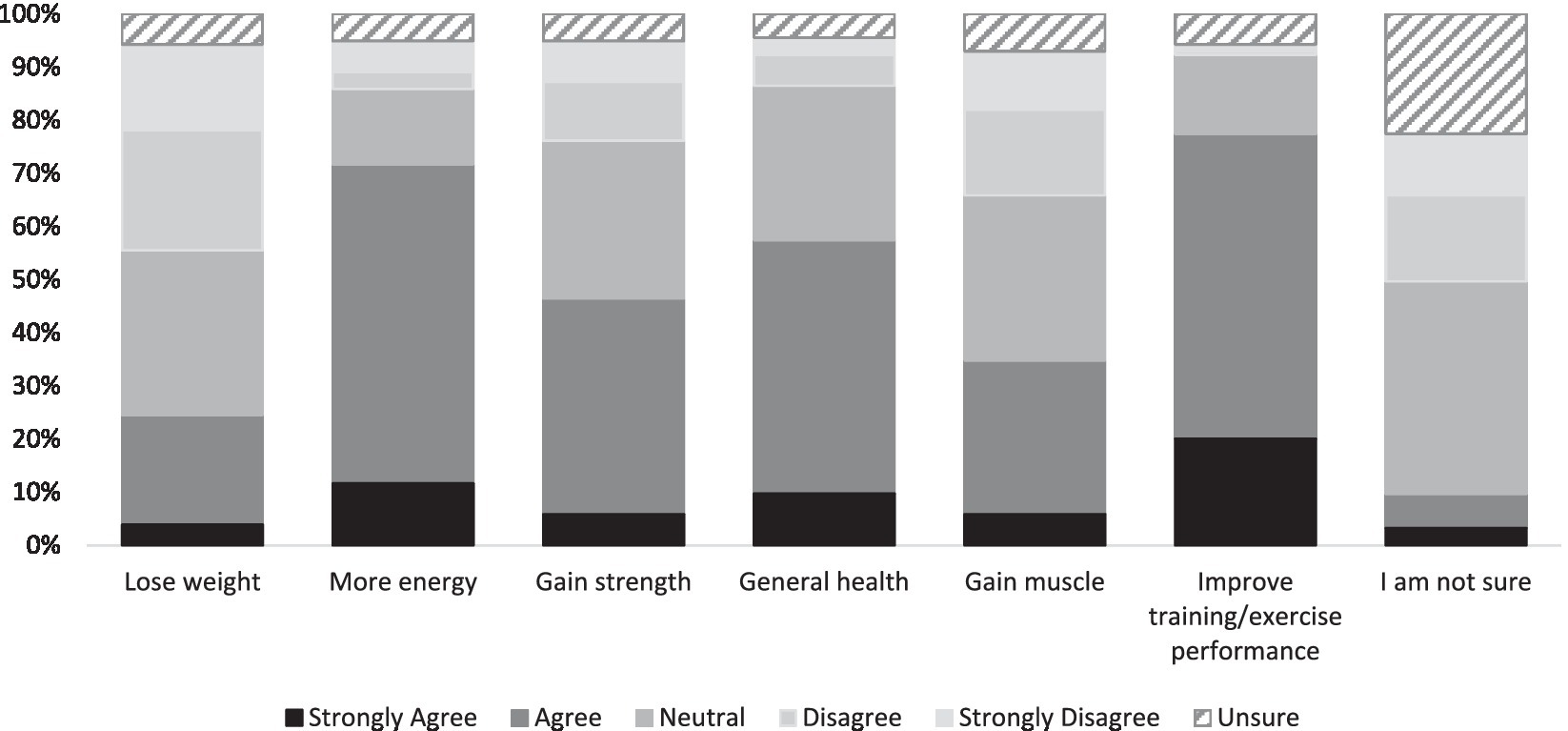
Figure 1. Reasons for taking dietary nitrate supplements. Data presented are the participants’ level of agreement with the reasons presented, expressed as a percentage.
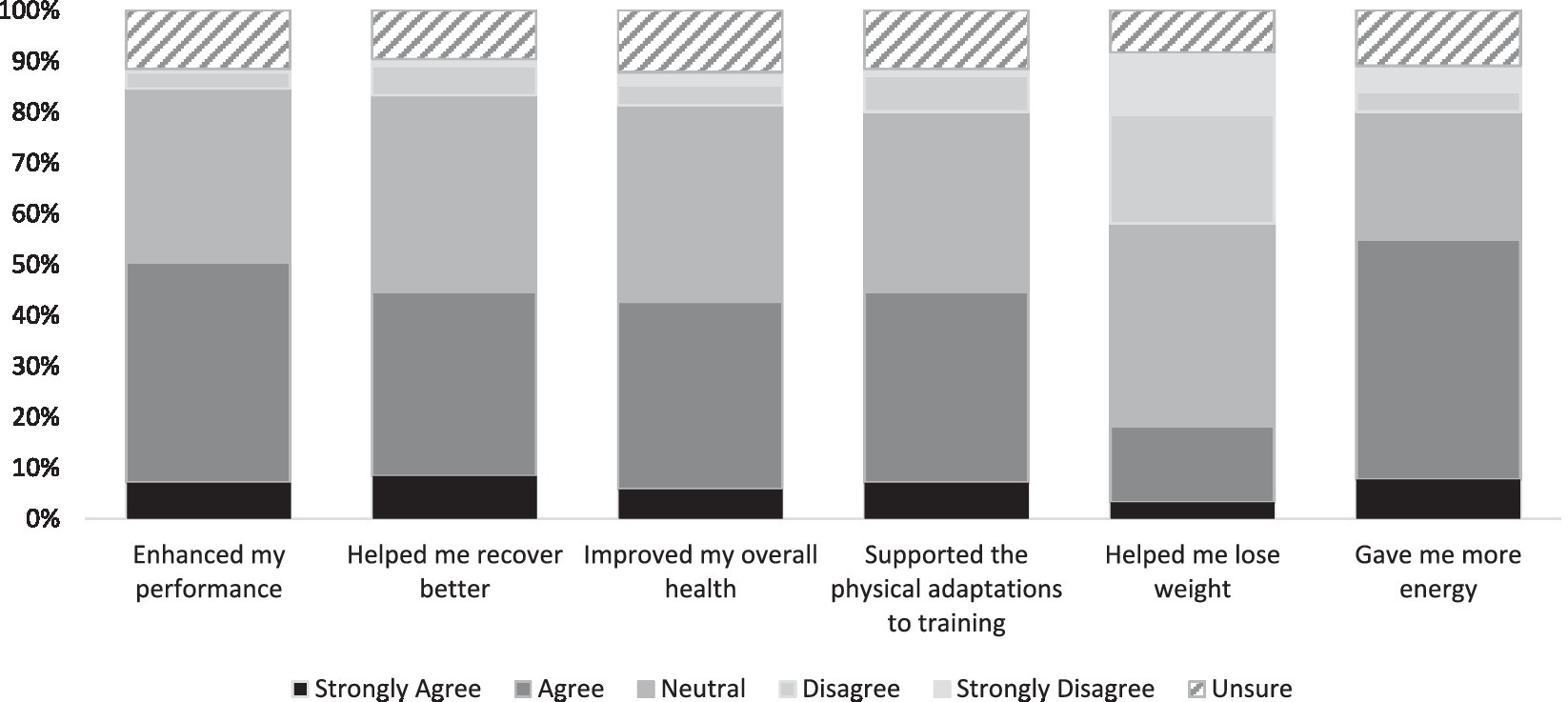
Figure 2. Experience using dietary nitrate supplements. Data presented are the participants’ level of agreement with the statements presented, expressed as a percentage.
Perceived safety of use of nitrate as a dietary supplement
About four in ten (39%) participants believe there are no health risks in supplementing their diets with NO3−, however, 37% admitted to being unsure about the safety of the supplement, but still took them anyway. Seven of the 154 users (4.5%) had experienced adverse effects from taking dietary NO3− supplements with symptoms including beeturia (red or pink urine) (n = 3), red stools (n = 4), gastrointestinal distress (n = 5), and 1 each for nausea and/or vomiting, headache, and lightheaded. Participants could select more than one symptom (Table 2).
Reasons for not using dietary nitrate supplements
Of the 1,115 participants reporting they had not used NO3− supplements (“non-users”) in the past, 42.3% reported they were unaware of its availability. Over one third of non-users reported they did not feel like dietary nitrate supplements were effective, and 60% felt they did not need dietary NO3− supplements because their diet was adequate (Figure 3).
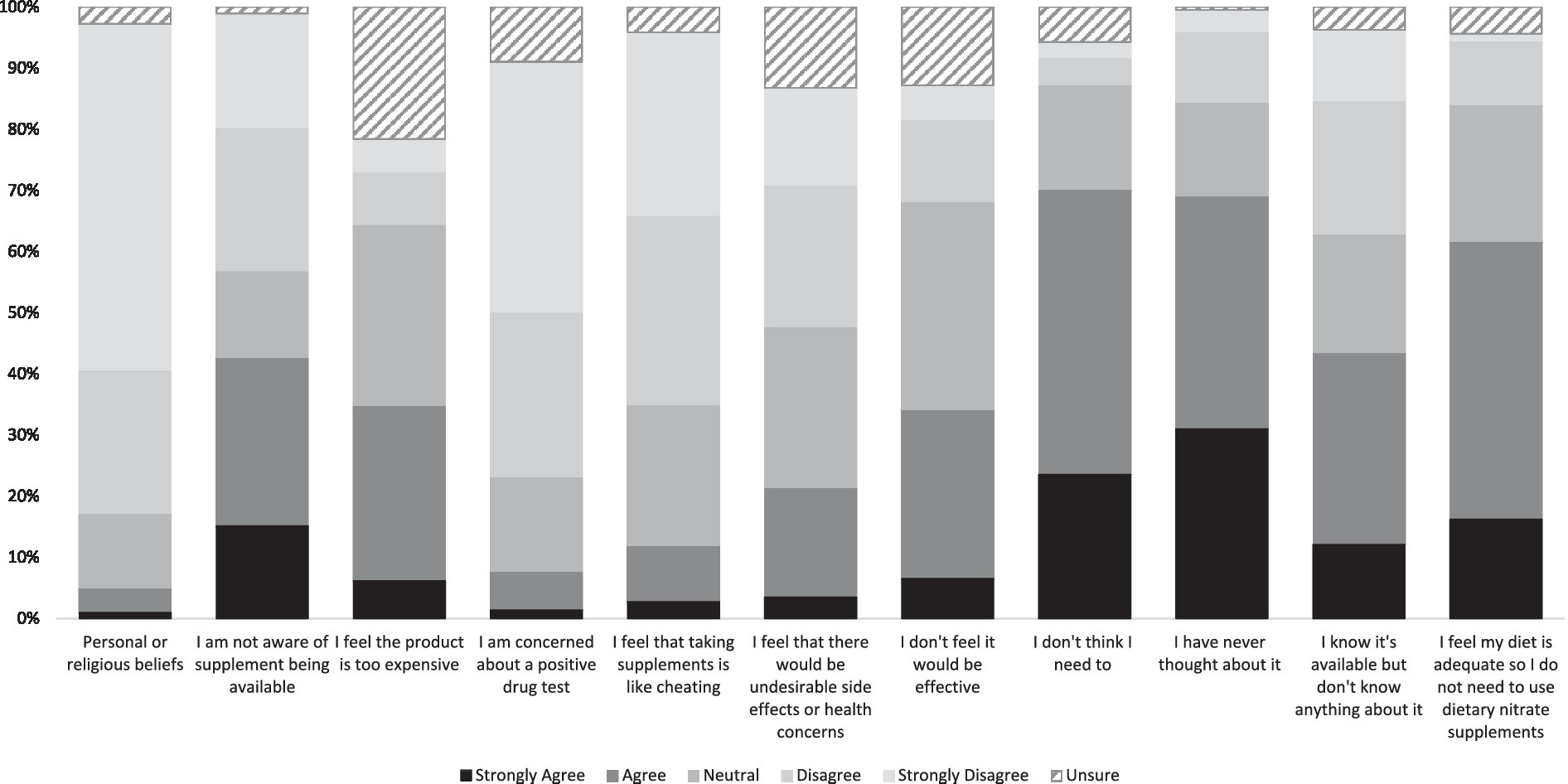
Figure 3. Reasons for non-use of dietary nitrate supplements. Data presented are the participants’ level of agreement with the reasons presented, expressed as a percentage.
Participants also reported that they were unsure if supplementing their diets with nitrate caused undesirable side effects or health conditions (25.3%). However, the majority (65.9%) reported they were not concerned about a positive drug test after supplementing with dietary NO3−.
Influence on supplement use
Participants identified various sources when asked what would influence their supplement use. Nutritionists and dietitians had the greatest influence (81.5%) followed by scientific journals (73.5%) and personal trainer/strength and conditioning coach/exercise physiologist (72.9%). Magazines (19.9%) and retail stores (13.9%) were reported as having the least amount of influence (Figure 4). Similar results were found when participants were asked what would provide the most credible source of information regarding supplement use with nutritionists and dietitians proving to be the most credible (84.1%), followed by scientific journals (78.8%) and government websites (71.5%). Retail stores (6.6%) and magazines (7.3%) were reported as the less credible sources of important regarding supplement usage (Figure 5).
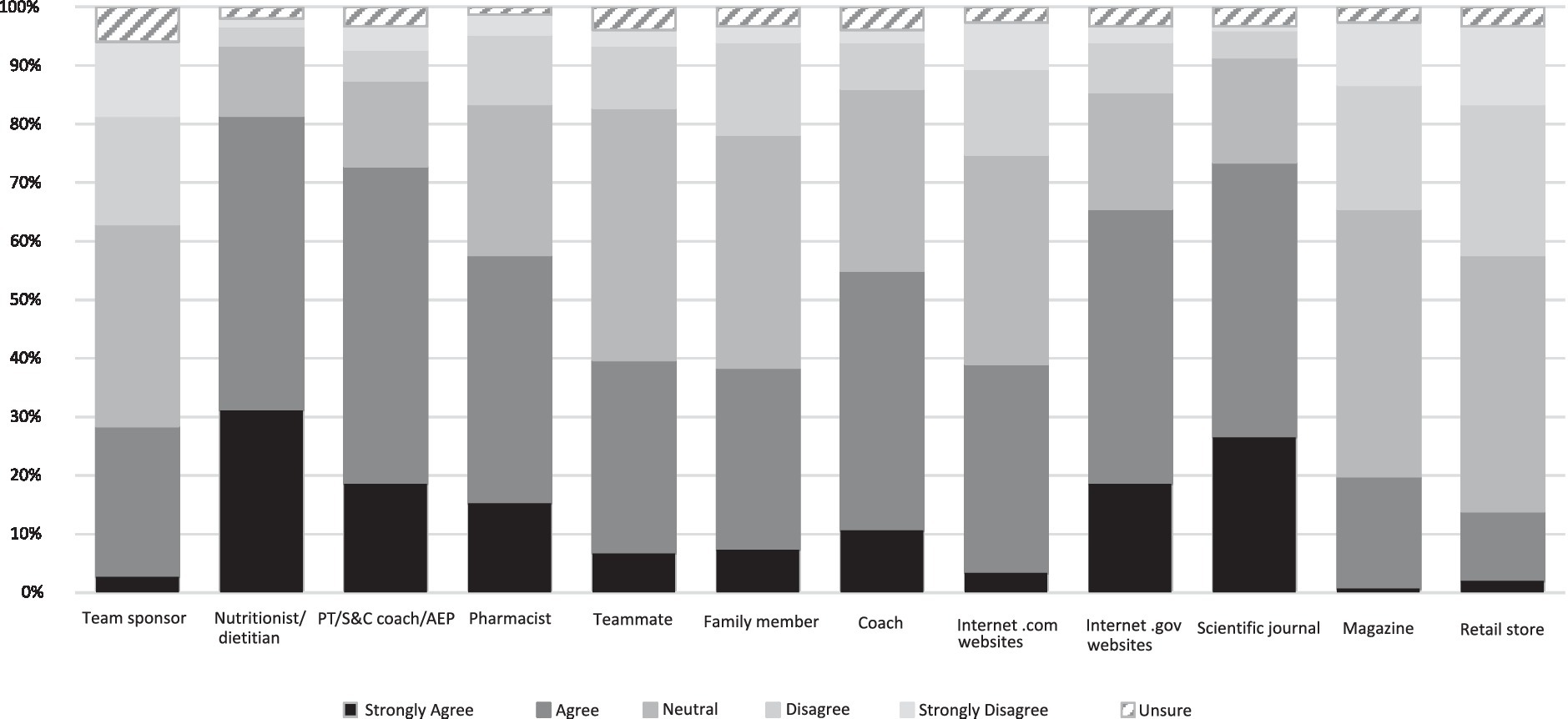
Figure 4. Influence of different information sources on participants’ supplement use. Data presented are the participants’ level of agreement with the information sources presented, expressed as a percentage. Abbreviations: PT, personal trainer; S&C, sports and conditioning; AEP, accredited exercise physiologist.
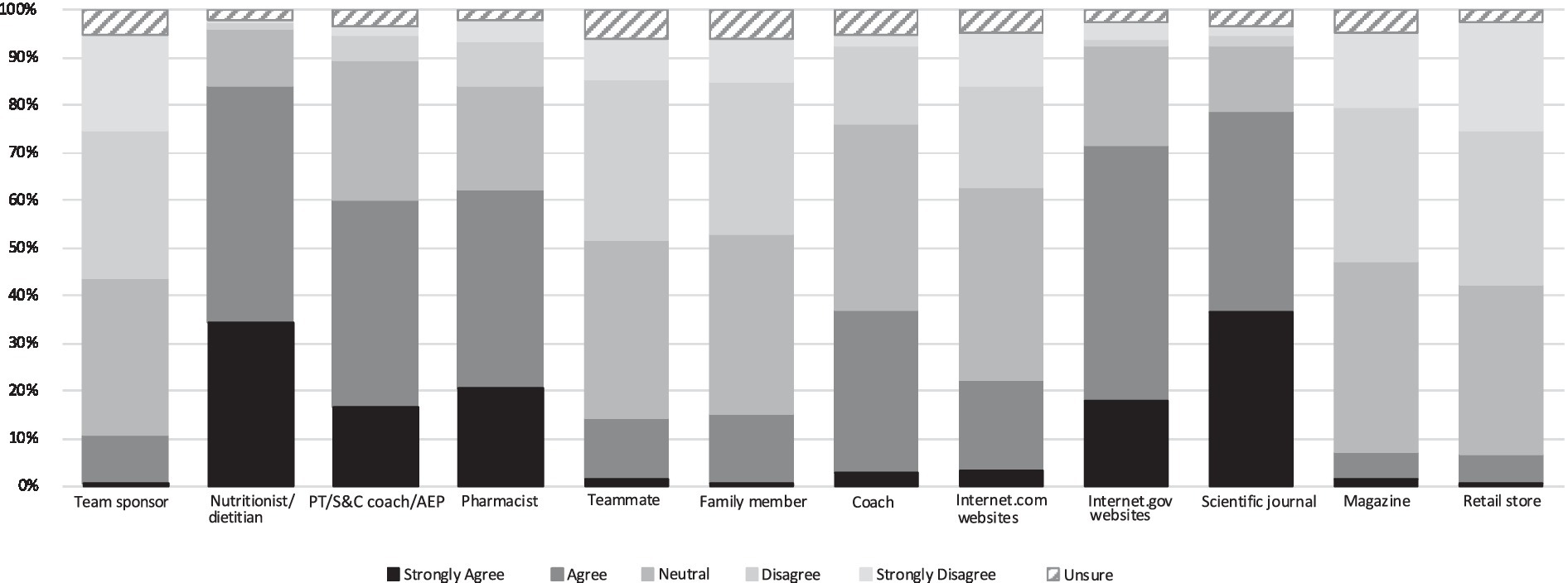
Figure 5. Perceptions of the credibility of different information sources. Data presented are the participants’ level of agreement with the information sources presented, expressed as a percentage. Abbreviations: PT, personal trainer; S&C, sports and conditioning; AEP, accredited exercise physiologist.
Dietary nitrate knowledge
Table 3 shows the participants’ self-reported level of knowledge regarding dietary NO3− supplementation. Approximately 20% of participants correctly identified (or guessed) the Australian Institute ABCD classification for nitrate (group A). Only 6.3% of participants could correctly identify that antibacterial mouthwash reduces the effectiveness of dietary NO3− supplements. Regarding the most appropriate use for nitrate supplementation, 14.3% of participants correctly identified that beetroot juice has been shown to be most effective 2–3 h prior to exercise.
Discussion
In the past decade, there has been a plethora of research (>100 trials) investigating the role of dietary nitrate. Despite this, to date, there had been no published papers which have collected data on real-world usage. The primary purpose of the study was to determine the use of dietary NO3− usage, the reason/s for use, and to compare knowledge and beliefs among active adults. The findings of this study showed the relative under-use of nitrate as a dietary supplement, with only 12% of the total sample reporting they had tried it, and of these, 61.2% had used the supplement for a period shorter than 6 months. There was a significant relationship found between gender and use of dietary NO3− supplements, with greater usage in males. This finding is congruent with the literature which shows males place more emphasis on performance. However, general supplement use is higher in women, largely driven by their interest in improving overall health (23–29), whereas males place more of an emphasis on athletic performance-enhancing factors (5, 9, 30). There has been a significant focus in recent years on dietary NO3− research tailored toward performance outcomes, however with research shifting toward health outcomes, positive results could create a shift in the gender gap.
Until recently, NO3− was grouped with the other N-nitroso compounds and was associated with several negative health outcomes (31–36) which may also partly explain the relatively low prevalence of use supported by our data, whereby 24% of those surveyed thought there were risks associated with taking dietary NO3− supplements. Of the dietary NO3− supplement users in the present study, 3.9% reported they had experienced minor adverse effects. Associated side-effects included beeturia (n = 2), red stools (n = 3), and gastrointestinal distress (n = 5). Similar effects were reported by McMahon et al. (12) and Stanaway et al. (37). No chronic or major adverse events were reported across the 59 studies or in the current population.
The most common information source for participants came from nutritionists, dietitians, exercise professionals and/or scientific journals. However, the knowledge section of the survey showed a limited understanding. While general knowledge of current dietary NO3− recommendations is not essential for every user (especially high-level athletes that place their trust in professionals working with them), it is important to be informed so that the best potential outcome can be achieved. Only 17.7% of users knew antibacterial mouthwash nullifies the effect of dietary NO3− supplementation. This is problematic because antibacterial mouthwash stops NO3− reductase activity of oral bacteria, resulting in the elimination of NO2− formation in the saliva (38). However, this lack of understanding comes back to the information source, and Shannon et al. (39) found that nutrition professionals’ knowledge about dietary NO3− was generally poor. It is hard to counterbalance incorrect information or misconceptions if those deemed the most reliable are unsure themselves. The confusion and lack of knowledge may be because of a nutritional supplement space that has grown rapidly, so an emphasis needs to be placed on adapting to information rapidly, efficiently, and effectively to achieve the best outcomes.
Educating support staff (e.g., nutritionists, coaches, exercise physiologists) is a useful strategy to improve the dissemination of nitrate knowledge, but this may be limited to individuals with access to such a support network, i.e., athletes. Harnessing the power and influence of social media could be a useful health-promotion tool to reach broader audiences (19). Behavior change is complex, and improving knowledge alone may not be sufficient in altering individuals’ use of nitrate supplements. Drawing from the behavior change wheel framework to design and evaluate interventions aimed at increasing the use of nitrate supplementation could be useful. At the core of the behavior change wheel is a model for behavior knowns as the COM-B model: Capability, Opportunity, and Motivation-Behavior (40). The COM-B model could be used to explore perceived barriers and facilitators to identify potential levers for change for adoption of nitrate supplementation to occur (41).
The strength of our research is the examination and new information on dietary NO3− usage, beliefs and knowledge. This could lead to the ability to access knowledge translation not only in dietary NO3− but also to supplement use and research in general. By providing new information, future research can focus on clear guidelines and a way to translate knowledge effectively. However, the study has several notable limitations. Most participants were young (≤25 years of age; 58.7%), low income (<$30,000 annual income; 57.1%) and recent secondary school graduates. This lack of diversity among socio-demographic data may not represent the community of active adults, compromising our ability to generalize findings from our study to the population. The questionnaire was based online and so respondents may have searched for answers to the questions before selecting their answer.
Conclusion
Only a small portion of the population are currently using dietary NO3− supplements. The knowledge of current recommendations is generally poor among the population. An emphasis needs to be placed on knowledge translation because supplement education programs have limited effectiveness. Once the barriers to knowledge translation are identified and improved upon, the information will reach credible sources and flow down to the public accurately and effectively, resulting in the best possible health/performance outcomes from using dietary NO3− supplements.
Data availability statement
The raw data supporting the conclusions of this article will be made available by the authors, without undue reservation.
Ethics statement
The studies involving humans were approved by Human Research Ethics Committee of The University of Queensland. The studies were conducted in accordance with the local legislation and institutional requirements. Written informed consent for participation in this study was provided by the participants’ legal guardians/next of kin.
Author contributions
NM: Conceptualization, Data curation, Formal analysis, Investigation, Methodology, Writing – original draft, Writing – review & editing. PB: Conceptualization, Data curation, Formal analysis, Investigation, Methodology, Writing – original draft, Writing – review & editing. TP: Supervision, Writing – review & editing. ML: Supervision, Writing – review & editing.
Funding
The author(s) declare financial support was received for the research, authorship, and/or publication of this article. This research has been supported by an Australian Government Research Training Program Scholarship.
Conflict of interest
The authors declare that the research was conducted in the absence of any commercial or financial relationships that could be construed as a potential conflict of interest.
Publisher’s note
All claims expressed in this article are solely those of the authors and do not necessarily represent those of their affiliated organizations, or those of the publisher, the editors and the reviewers. Any product that may be evaluated in this article, or claim that may be made by its manufacturer, is not guaranteed or endorsed by the publisher.
Supplementary material
The Supplementary material for this article can be found online at: https://www.frontiersin.org/articles/10.3389/fnut.2023.1291431/full#supplementary-material
References
1. World Health Organization. Global nutrition policy review 2016–2017: Country Progress in creating enabling policy environments for promoting healthy diets and nutrition. Geneva: World Health Organization (2018).
2. Lawand, L, Youness, R, Sinno, L, Lawand, N, and Al Tabbah, S. Assessment of dietary supplements use among American University of Beirut students: prevalence, knowledge, and reasons for supplementation. J Diet Suppl. (2023) 20:106–17. doi: 10.1080/19390211.2021.1981512
3. Burns, RD, Schiller, MR, Merrick, MA, and Wolf, KN. Intercollegiate student athlete use of nutritional supplements and the role of athletic trainers and dietitians in nutrition counseling. J Am Diet Assoc. (2004) 104:246–9. doi: 10.1016/j.jada.2003.11.013
4. Erdman, KA, Fung, TS, and Reimer, RA. Influence of performance level on dietary supplementation in elite Canadian athletes. Med Sci Sports Exerc. (2006) 38:349–56. doi: 10.1249/01.mss.0000187332.92169.e0
5. Froiland, K, Koszewski, W, Hingst, J, and Kopecky, L. Nutritional supplement use among college athletes and their sources of information. Int J Sport Nutr Exerc Metab. (2004) 14:104–20. doi: 10.1123/ijsnem.14.1.104
6. Goston, JL, and Correia, MI. Intake of nutritional supplements among people exercising in gyms and influencing factors. Nutrition. (2010) 26:604–11. doi: 10.1016/j.nut.2009.06.021
7. Huang, SH, Johnson, K, and Pipe, AL. The use of dietary supplements and medications by Canadian athletes at the Atlanta and Sydney Olympic games. Clin J Sport Med. (2006) 16:27–33. doi: 10.1097/01.jsm.0000194766.35443.9c
8. Kristiansen, M, Levy-Milne, R, Barr, S, and Flint, A. Dietary supplement use by varsity athletes at a Canadian university. Int J Sport Nutr Exerc Metab. (2005) 15:195–210. doi: 10.1123/ijsnem.15.2.195
9. Slater, G, Tan, B, and Teh, KC. Dietary supplementation practices of Singaporean athletes. Int J Sport Nutr Exerc Metab. (2003) 13:320–32. doi: 10.1123/ijsnem.13.3.320
10. Arensberg, M, Costello, R, Deuster, P, Jones, D, and Twillman, G. Summit on human performance and dietary supplements summary report. Nutr Today. (2014) 49:7–15. doi: 10.1097/NT.0000000000000013
11. Pramuková, B, Szabadosová, V, and Soltésová, A. Current knowledge about sports nutrition. Australas Med J. (2011) 4:107–10. doi: 10.4066/AMJ.2011.520
12. McMahon, NF, Leveritt, MD, and Pavey, TG. The effect of dietary nitrate supplementation on endurance exercise performance in healthy adults: a systematic review and Meta-analysis. Sports Med. (2017) 47:735–56. doi: 10.1007/s40279-016-0617-7
13. Jones, AM, Thompson, C, Wylie, LJ, and Vanhatalo, A. Dietary nitrate and physical performance. Annu Rev Nutr. (2018) 38:303–28. doi: 10.1146/annurev-nutr-082117-051622
14. Senefeld, JW, Wiggins, CC, Regimbal, RJ, Dominelli, PB, Baker, SE, and Joyner, MJ. Ergogenic effect of nitrate supplementation: a systematic review and Meta-analysis. Med Sci Sports Exerc. (2020) 52:2250–61. doi: 10.1249/MSS.0000000000002363
15. Jones, AM. Dietary nitrate supplementation and exercise performance. Sports Med. (2014) 44:35–45. doi: 10.1007/s40279-014-0149-y
16. Stanojević-Ristić, Z, Stević, S, Rašić, J, Valjarević, D, Dejanović, M, and Valjarević, A. Influence of pharmacological education on perceptions, attitudes and use of dietary supplements by medical students. BMC Complement Altern Med. (2017) 17:527. doi: 10.1186/s12906-017-2031-6
17. Kim, DY, and Kim, H-Y. Trust me, trust me not: a nuanced view of influencer marketing on social media. J Bus Res. (2021) 134:223–32. doi: 10.1016/j.jbusres.2021.05.024
18. Suarez-Lledo, V, and Alvarez-Galvez, J. Prevalence of health misinformation on social media: systematic review. J Med Internet Res. (2021) 23:e17187. doi: 10.2196/17187
19. Denniss, E, Lindberg, R, and McNaughton, SA. Nutrition-related information on Instagram: a content analysis of posts by popular Australian accounts. Nutrients. (2023) 15:2332. doi: 10.3390/nu15102332
20. Graham, ID, Logan, J, Harrison, MB, Straus, SE, Tetroe, J, Caswell, W, et al. Lost in knowledge translation: time for a map? J Contin Educ Heal Prof. (2006) 26:13–24. doi: 10.1002/chp.47
21. Landis, JR, and Koch, GG. The measurement of observer agreement for categorical data. Biometrics. (1977) 33:159–74. doi: 10.2307/2529310
22. Australian Bureau of Statistics (ABS). Australian health survey: Physical activity, 2011–12. Australia, Canberra: (2013).
23. Bailey, RL, Gahche, JJ, Lentino, CV, Dwyer, JT, Engel, JS, Thomas, PR, et al. Dietary supplement use in the United States, 2003-2006. J Nutr. (2011) 141:261–6. doi: 10.3945/jn.110.133025
24. Kim, HJ, Giovannucci, E, Rosner, B, Willett, WC, and Cho, E. Longitudinal and secular trends in dietary supplement use: Nurses' health study and health professionals follow-up study, 1986-2006. J Acad Nutr Diet. (2014) 114:436–43. doi: 10.1016/j.jand.2013.07.039
25. Kishiyama, SS, Leahy, MJ, Zitzelberger, TA, Guariglia, R, Zajdel, DP, Calvert, JF Jr, et al. Patterns of dietary supplement usage in demographically diverse older people. Altern Ther Health Med. (2005) 11:48–53.
26. O'Brien, SK, Malacova, E, Sherriff, JL, and Black, LJ. The prevalence and predictors of dietary supplement use in the Australian population. Nutrients. (2017) 9:1154. doi: 10.3390/nu9101154
27. Spencer, EH, Bendich, A, and Frank, E. Vitamin and mineral supplement use among us medical students: a longitudinal study. J Am Diet Assoc. (2006) 106:1975–83. doi: 10.1016/j.jada.2006.09.003
28. Steele, M, and Senekal, M. Dietary supplement use and associated factors among university students. South Afr J Clin Nutr. (2005) 18:17–30. doi: 10.1080/16070658.2005.11734034
29. van der Horst, K, and Siegrist, M. Vitamin and mineral supplement users. do they have healthy or unhealthy dietary Behaviours? Appetite. (2011) 57:758–64. doi: 10.1016/j.appet.2011.08.020
31. Dorsch, MM, Scragg, RK, McMichael, AJ, Baghurst, PA, and Dyer, KF. Congenital malformations and maternal drinking water supply in rural South Australia: a case-control study. Am J Epidemiol. (1984) 119:473–86. doi: 10.1093/oxfordjournals.aje.a113764
32. Gupta, SK, Gupta, RC, Gupta, AB, Seth, AK, Bassin, JK, and Gupta, A. Recurrent acute respiratory tract infections in areas with high nitrate concentrations in drinking water. Environ Health Perspect. (2000) 108:363–6. doi: 10.1289/ehp.00108363
33. Malberg, JW, Savage, EP, and Osteryoung, J. Nitrates in drinking water and the early onset of hypertension. Environ Pollut. (1970), 1978) 15:155–60.
34. Mirvish, SS. N-Nitroso compounds: their chemical and in vivo formation and possible importance as environmental carcinogens. J Toxicol Environ Health. (1977) 2:1267–77. doi: 10.1080/15287397709529529
35. Morton, WE. Hypertension and drinking water constituents in Colorado. Am J Public Health. (1971) 61:1371–8. doi: 10.2105/AJPH.61.7.1371
36. SUPER, M, HEESE, H, MACKENZIE, D, DEMPSTER, W, DUPLESSIS, J, and FERREIRA, J. An epidemiological study of well-water nitrates in a Group of South West African/Namibian infants. Water Res. (1981) 15:1265–70. doi: 10.1016/0043-1354(81)90103-2
37. Stanaway, L, Rutherfurd-Markwick, K, Page, R, and Ali, A. Performance and health benefits of dietary nitrate supplementation in older adults: a systematic review. Nutrients. (2017) 9:1171. doi: 10.3390/nu9111171
38. Govoni, M, Jansson, EÅ, Weitzberg, E, and Lundberg, JO. The increase in plasma nitrite after a dietary nitrate load is markedly attenuated by an antibacterial mouthwash. Nitric Oxide. (2008) 19:333–7. doi: 10.1016/j.niox.2008.08.003
39. Shannon, OM, Grisotto, G, Babateen, A, McGrattan, A, Brandt, K, Mathers, JC, et al. Knowledge and beliefs about dietary inorganic nitrate among Uk-based nutrition professionals: development and application of the kinds online questionnaire. BMJ Open. (2019) 9:e030719. doi: 10.1136/bmjopen-2019-030719
40. Michie, S, van Stralen, MM, and West, R. The behaviour change wheel: a new method for Characterising and designing behaviour change interventions. Implement Sci. (2011) 6:42. doi: 10.1186/1748-5908-6-42
Keywords: dietary supplements, nitrate, knowledge, prevalence of use, exercise performance, survey
Citation: McMahon NF, Brooker PG, Pavey T and Leveritt MD (2023) Assessment of dietary nitrate supplementation: prevalence of use, knowledge, attitudes and beliefs among active Australians. Front. Nutr. 10:1291431. doi: 10.3389/fnut.2023.1291431
Edited by:
Mark Elisabeth Willems, University of Chichester, United KingdomReviewed by:
Anna Kiss, University of Szeged, HungaryOliver Shannon, Newcastle University, United Kingdom
Copyright © 2023 McMahon, Brooker, Pavey and Leveritt. This is an open-access article distributed under the terms of the Creative Commons Attribution License (CC BY). The use, distribution or reproduction in other forums is permitted, provided the original author(s) and the copyright owner(s) are credited and that the original publication in this journal is cited, in accordance with accepted academic practice. No use, distribution or reproduction is permitted which does not comply with these terms.
*Correspondence: Paige G. Brooker, cC5icm9va2VyQHVxLmVkdS5hdQ==
 Nicholas F. McMahon1
Nicholas F. McMahon1 Paige G. Brooker
Paige G. Brooker Toby Pavey
Toby Pavey Michael D. Leveritt
Michael D. Leveritt
